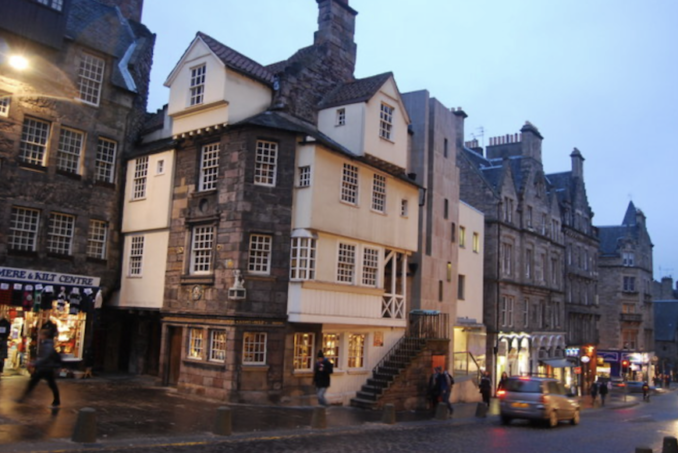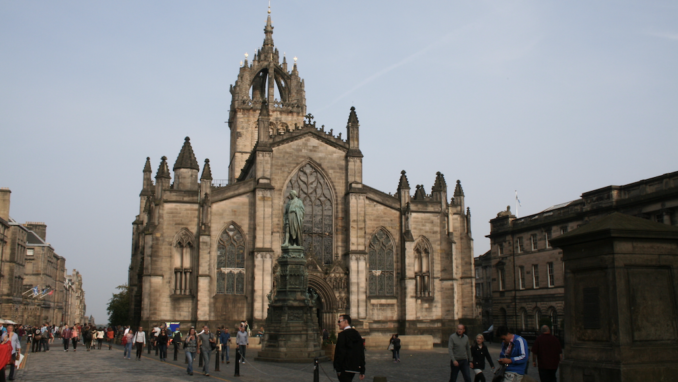I have a strange sensation in my trousers while strolling Edinburgh’s Royal Mile arm in arm with Mrs AWS. Behave yourselves. Regular readers will be unsurprised to learn my work colleagues pay me not to attend our Christmas party.
My Harold Wilson and Tommy Cooper impersonations irritate young ladies in their twenties who weren’t born when great men talked of the pound in their pocket being ‘not like that, like that.’ A ha ha ha.
As for the dad jokes. Trigger warning.
‘I didn’t realise you’re on tills.’
‘I’m not.’
‘Get back to your aisle then.’
‘You can’t tell me what to do, you’re not my dad.’
‘If I was, I’d still be bathing you.’
Oh dear. I’m lame, just not funny, need some new material, and Bernard Manning getting the laugh in the 1970s is no defence in front of a 21st-century shop-floor minimum-wage wokeist lawyer. Here’s a crisp Scottish tenner – don’t come to the party. Burning a hole in my pocket during myself and Mrs AWS’s day drip to the Scottish capital, where to spend? What would John Knox do? Hang on to it. All the same, there is a John Knox House on Edinburgh’s Royal Mile where you can spend your money.
John Knox House
Situated at the intersection of High Street and Netherbow, near the eastern end of the thoroughfare, John Knox House is one of the oldest surviving houses in the city. Dating back to the late 15th century, it is a significant landmark due to its association with Knox, the leader of the Scottish Reformation.
Although he only lived in the house for a short period before his death in 1572, the building is named after him and is believed to have been his residence. John Knox played a pivotal role in the Reformation, which sought to reform the Church of Scotland and established an austere Presbyterianism as the national religion. Although the structure underwent various alterations and restorations over the centuries, it retains many original features offering a glimpse into 16th-century life in Edinburgh.
Step inside John Knox House and you’ll find more than a museum. It’s a time machine immersing tourists in the Reformation era. The exhibits, including period furnishings, artefacts, and interactive displays, bring to life the story of John Knox’s life and work and scenes from the Bible reflecting the religious fervour of the era.

John Knox House, The Royal Mile,
N Chadwick – Licence CC BY-SA 2.0
In addition to its historical significance, John Knox House is often associated with numerous legends and stories. One such legend claims the house is haunted by the ghost of John Knox himself, adding an element of intrigue for visitors interested in the supernatural.
The attraction is managed by the Church of Scotland and is open to the public as part of the Scottish Storytelling Centre. This offers a range of events and activities celebrating Scotland’s literary and storytelling traditions, making it a vibrant cultural hub on the Royal Mile.
We hurried past, my tenner still intact.
As for the Scottish Reformation, the 16th century marked a transformative shift from Catholicism to Protestantism. Dissatisfaction with the Catholic Church’s corruption and the influence of the broader European Reformation, led by figures like Martin Luther and John Calvin, spurred change. John Knox, a pivotal leader who studied under Calvin, returned to Scotland with a mission to reform the church. His fiery sermons, such as the one that sparked the St. Giles’ Riots in 1559 when Knox was the cathedral’s minister, catalysed open rebellion against Catholicism. The Protestant Lords of the Congregation seized key cities and demanded reform.
The Treaty of Edinburgh in 1560 was crucial in ending the conflict between Protestant rebels and French forces supporting Mary of Guise – James V’s second wife whose coat of arms we spotted at Holyroodhouse Palace in a previous episode. This treaty facilitated the withdrawal of the foreign troops and the establishment of a Protestant governing council.
The same year, the Scottish Parliament adopted the Scottish Confession of Faith, rejecting papal authority and Catholic practices, and established a Presbyterian Church governed by elected elders and ministers. This reform emphasised education and literacy, leading to the founding of Scotland’s excellent schools and outstanding literacy rates, which survived until the present SNP government.
St Giles Cathedral
Founded as a Roman Catholic church in the 12th century, St Giles Cathedral lies further along the Royal Mile. Dedicated to St Giles, the patron saint of Edinburgh and lepers, the church has undergone numerous modifications and expansions over the centuries, reflecting the various styles and historical periods it’s witnessed. One of St Giles’ most distinctive features is its impressive crown steeple, added in the late 15th century. This unique element, resembling an imperial crown, has become an iconic symbol of Edinburgh’s skyline. The interior of the cathedral is striking, with high vaulted ceilings, intricate stonework, and beautiful stained glass windows.
Visitors can explore several notable features, including the ornate Thistle Chapel built in 1911. This is the spiritual home of the Order of the Thistle, Scotland’s highest order of chivalry. The chapel is renowned for its exquisite woodwork, carvings, and beautiful stained glass windows.

Edinburgh: High Kirk of St Giles,
Dr Neil Clifton – Licence CC BY-SA 3.0

360° Panorama of the interior of St. Giles’ Cathedral, Edinburgh.,
Farwestern – Licence CC BY-SA 2.0
The Preston Aisle houses several significant memorials and monuments, including those dedicated to notable Scots such as James Graham, Marquis of Montrose, and Robert Louis Stevenson. St Giles boasts an array of stunning stained glass windows, many of which depict biblical scenes and figures. These windows were installed during the Victorian era and later and add vibrant colours and intricate designs to the cathedral’s interior.
A statue of John Knox stands inside the cathedral, commemorating his role in the Scottish Reformation and his association with St Giles’. St Giles’ Cathedral is a place of worship and a venue for cultural and civic events. It hosts concerts, lectures, and ceremonies, contributing to Edinburgh’s cultural life.
Queen Elizabeth II was taken to St Giles after her death on September 8, 2022, at Balmoral Castle. Here, the public could pay their respects. Draped in the Royal Standard of Scotland, the Queen’s coffin was surrounded by the ancient and beautiful architecture of St. Giles. Thousands of mourners from all walks of life paid homage to the longest-reigning monarch in British history. A continuous vigil was kept by members of the Royal Company of Archers, the Queen’s Bodyguard for Scotland.
The Tolbooth Kirk
As we approach the westernmost extreme of the Royal Mile, and the top of a challenging climb on a warm May day, we reach yet another church – the Tolbooth Kirk. Close to the entrance to Edinburgh Castle and now called The Hub, the prominent landmark was constructed between 1842 and 1845. Designed by the architect James Gillespie Graham in collaboration with renowned Gothic Revival architect Augustus Pugin. Puffins will recall it was Pugin who designed Westminster’s House of Liars And Thieves.
The church was built to serve as the parish church for the growing population of the Old Town and the nearby Grassmarket area. The church’s name, “Tolbooth,” refers to its proximity to the Old Tolbooth, which was Edinburgh’s main municipal building and jail. The building is characterised by its tall spire, which is one of the tallest in Edinburgh, rising to 241 feet. The spire is a key feature of the city’s skyline and is visible from many parts of Edinburgh.

View from Castlehill, Edinburgh,
Dave Hitchborne – Licence CC BY-SA 2.0
The exterior of the Tolbooth Kirk is adorned with intricate stonework, pointed arches, and detailed carvings, typical of the Gothic style. The large stained glass windows add to the building’s grandeur, allowing light to flood into the interior space. In the late 20th century, the Tolbooth Kirk underwent significant changes. Declining congregations and the need for extensive repairs led to the decision to repurpose the building. In the early 1990s, it was transformed into The Hub, the headquarters of the Edinburgh International Festival.
Today, according to the guff, The Hub is a vibrant cultural centre and events venue. It hosts a variety of events throughout the year, including concerts, performances, conferences, and weddings. During the Edinburgh Festival in August, The Hub becomes a focal point for festival activities, providing a central location for ticket sales, information, and performances. The building retains many of its original architectural features, with modern additions enhancing its functionality as a contemporary events space. The interior includes a large auditorium, meeting rooms, a café, and office space for the festival’s administrative staff.
Not sure I approve.
At one time, the Tolbooth Kirk provided assembly rooms for the Church of Scotland. These days, the General Assembly Hall of the Church of Scotland is situated nearby on the northern side of Castlehill. As we found out last time, Edinburgh’s Holyrood Parliament Building ran late and was way over budget. During the interim, the Scottish parliament met at the Assembly Hall. In keeping with the spirit of Knox and Calvin, the Kirk did not allow smoking or the consumption of alcohol on the premises.
On dreich Scottish days, with a gale blowing from the Forth, MSPs were to be seen standing outside having a fly smoke and drinking from sodden carry-oots while soaked to the skin and freezing cold — something we can all approve of.
The future of the Tolbooth Church could have been different. In 1982, beneath the headline ‘From Kirk to Court?’ a newspaper reported the Church of Scotland’s backing of a proposal to turn the famous Edinburgh kirk into a sheriff’s court. ‘Despite its distinguished past, it was put on the market earlier this year — another victim of the church’s embarrassment of property. No buyer emerged.’
The proposal was the brainchild of conservation watchdogs, the Cockburn Association, together with the Scottish Civic Trust, who organised three meetings of interested parties to discuss the future of the kirk. The convener of the kirk’s board of practice and procedure, the Rev James Weatherhead, said the church would favour the proposal.
However, addressing the small print and reading between the lines, shows the Rev Weatherhead’s concern (and rightly so) to be with palming off the monthly scaffolding bill for the damaged spire – the highest point on Edinburgh’s skyline.
John Knox would have approved!
© Always Worth Saying 2024



